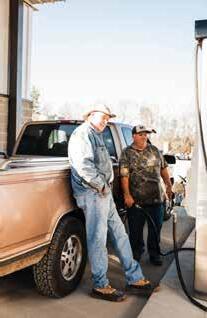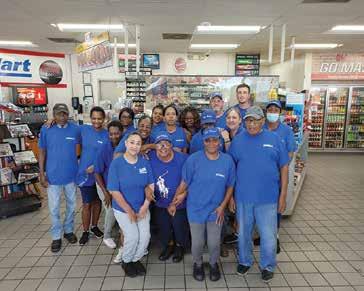







































Celebrate our Natchez Renewal with us!


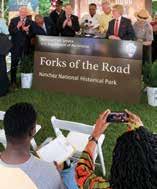
Over 1,000 New Jobs. Over 1,000 Homes Purchased. Over $100 Million in Grants & Appropriations for Natchez & our Partners. Growing Movie Industry. Workforce Development on the Rise. Booming Tourism. Non-Stop Riverboat Traffic.




Yes, in Natchez, our historic charm and enchanting sunsets are alluring. But our recent renewal efforts have transformed our “Small Town” into a “Smart Town” and a cultural tourism and business hub for Southwest Mississippi. As the oldest city on the highest bluff of the mightiest river, our view inspires reflection. Ours is a higher view - setting the example for what can be achieved when we all work together. We’re doing it in Natchez. Let’s be the inspiration for Mississippi!


“America’s
For Natchez. For Mississippi. Stronger together




BUILDING A BETTER BUSINESS
How one entrepreneur succeeded
10 36
CHIEF MAGIC MAKER
Joseph A.C. Smith shares his vision
14
EDUCATION IN INNOVATION
STEM comes to life
42 17 44
God’s Grace flourishes in congregation, pastor

PROVIDING
Nature abounds in photographer’s viewfinder
Transportation through the ages
A leap of faith for one nurse
Their stories are inspirational For
As part of the Global Medical Response family of solutions, American Medical Response (AMR) and Air Evac Lifeteam deliver compassionate, quality medical care to the Miss-Lou. When a medical emergency occurs, we are there for you at a moment’s notice. Patients can count on our experienced caregivers to provide prompt, safe and thoughtful care in their time of need.
With our combined expertise and resources, AMR and Air Evac Lifeteam can offer you unmatched medical transportation services—on the ground and in the air. Our paramedics, EMTs, flight nurses and pilots set the standard for pre-hospital care, enhancing the communities we serve.
911 Emergency Ambulance - 24 hours a day, seven days a week, our experienced EMS professionals and caregivers are ready to help you in an emergency
Interfacility Transportation - safely moving patients from one healthcare facility to another
Community Training - dedicated to saving lives by teaching the community compression-only CPR and Stop the Bleed techniques
Carpentry, especially the kind that James Germany and Adam Gwin do, is an art form in the truest sense.
Both men have been sought after for restoring pieces of history throughout Natchez and the Miss-Lou. Doing so at times has required them to create something from scratch that isn’t there with only their imagination or a picture acting as their guide.
The latter was the case for
James “Peco” Germany when he constructed new towers for The Towers, a home for which the original construction started around 1720.
Historic Natchez Director Emeritus Mimi Miller has called it Germany’s legacy project. “But I don’t look at it as a legacy. I just look at it as a job,” he said.
The two rooms on the third story for which the historic structure was named burned in the 1920s and
“
“She had a picture of the towers in the foyer and that was all the information we had. I took that picture, graphed it, blew it up on my phone and made it. It liked to wore me out. I was 50 years old and there I was climbing 50 feet in the air every day to go to work.”
— James Germany

”
a previous owner had decided to have them removed altogether. Current owners Ginger Highland and her husband James hired Germany to rebuild an outer shell of these two rooms to match photographs of the original house.
Germany said the project was a test of his carpentry skills.
“She had a picture of the towers in the foyer and that was all the information we had. I took that picture, graphed it, blew it up on my phone and made it,” he said. “It liked to wore me out. I was 50 years old and there I was climbing 50 feet in the air every day to go to work.”
Germany has had many other projects on historic houses throughout the greater Natchez area. His latest project is working on the Magruder-Scott house in Woodville, built-in 1809.
Germany, now 66 years old, has been at work since he was 16 years old but did not start doing carpentry until after the oil industry died down in the 1980s, he said.
Born in the Kingston community, Germany’s first job was offloading heavy bags from trucks that made deliveries to a local feed store. Germany said he “hated school” and got a work release from his parents so he could go to work full-time and attend school every two weeks. After he had stopped working in the oil business, he held several jobs, including working at a video store with his father, millwright maintenance worker and iron worker before finally settling into carpentry.
He had learned “the basics” and more advanced carpentry skills from other carpenters before he decided to work for himself, he said.
A project of which he is particularly proud is a two-story brick house at 500 S. Wall St. in Downtown Natchez that he restored for Gary Baldwin.
“All of the mantle and trim was off in one room and we had to put it back,” he said. “The mantels were stolen and sold to an antique dealer in Bay Springs. When Gary found them, the guy let us come in and we took 94 pictures and measurements.”
It was one of his first serious jobs as a contractor, short of building his own house that he still lives in and updates himself. His house he built “for practice” and made a lot of mistakes with it, he said. “I could barely read a tape measure and had to use the square to draw a straight line,” he said.
Germany had been in an accident where a shard of glass split his dominant eye, which he still can’t see out of to this day. “Little James,” his youngest son who is now 17, had just been born and he had recently become sober when he started working for the Baldwins — unable to see out of one eye and without a shop to work in. Still, Germany built the mantels from scratch on his front porch, he said. Now 33 years into the carpentry

business, Germany said he doesn’t see himself ever retiring. When he’s not out doing a carpentry job he is usually cooking, working in his garden, canning vegetables, hunting or doing house chores. Cooking is among his favorite hobbies. The house work he does out of necessity, he said.
Adam Gwin also does a lot of carpentry and restoration work around Natchez but focuses on furniture. He works full-time out of his shop at 102 S. Dr. Martin Luther King Jr. St.
While carpentry was not his first career choice, it was a skill Gwin found when he was barely a teenager, he said.
He recalled at the age of 12 making his first sketch of a sideboard his dad wanted that he would carve out of Cypress wood found on the lake.
“He didn't think he could do it,” Gwin said. “I sat down the next morning at Dad’s lake house and drew a drawing of how to make a sideboard like he wanted. So, I've been interested in furniture practically my entire life.”
He had gone to college planning to be a lawyer but instead worked in sales. Between sales jobs, he became an apprentice to someone restoring antique furniture.
“And turns out I was good at it,” he said.
He’d been at it 16 years before he rented a woodworking shop to make it a full-time career, he said. In addition to restoring antiques, he had made several original pieces on request to fit the space and needs of his custom-
ers — a bed, a footstool, a table.
“I had been building things with the tutelage of other people who knew what they were doing and that was the only training I had. I basically taught myself everything other than the very basics and then I just figured everything else out on my own,” he said.
“Throughout the centuries, people like me have made their living filling specific spaces. So, you come to me and there's a piece of furniture that you need to fit in that in a specific spot and I fill that need.”
Gwin said a lesson that he picked up from working in sales was, “Buyers are liars; They don't really know what they want. I learned that you have to listen to what people say in between their words to hear what they really want or need and then show them that. And that's what I do.”
However, one of his favorite pieces he has built was exactly what the customer said she wanted. It was a chest of drawers made of Cherry with four drawers and a holly inlay he made for a friend from church. It was so beautiful that he wanted to build two of them, one for her and one for himself, but he didn’t have enough time for both before another project he had on the books, he said.
Nearly nine years later, she was in the middle of moving and decided to trade another chest of drawers for it, “So I gave her the chest I had that was a good chest and I got back my favorite piece of furniture I've ever built,” he said.
Gwin has a fascination for history as much as carpentry. He likes the period of American furniture between 1790 and about 1830, which coincides with the regency period of England.
“Simple elegance is my moniker,” he said. “It’s slender, simple lines.”
Restoring an old piece of furniture is often more difficult than building a new one from scratch, he said. Many pieces are complex and have to be taken apart to understand how they are made, what needs fixing, and then put back together. A dining room table, for instance, is more than just a flat top with four legs. One table in his shop now adjusts like an accordion with a web of parts underneath and slats to go on top, making it smaller or larger.
While working on an old bookcase in his shop that had nearly been destroyed in a house fire, Gwin noticed the original carpenter’s handwriting still preserved on the pieces — lines, measurements, and a date in the 1800s followed by the creator’s signature — so faded he could barely read them.
Gwin said his creations would outlive him, much like the creations of the carpenters whose pieces he had restored.
“My dad's a lawyer, and he said something to me years ago that I really do appreciate. He said that when he dies, his name will be on a bunch of papers in a courthouse somewhere. ... When I die, there will be creations everywhere that are unique to me.”
STORY
PHOTOS BY STACY GRANING
In 2010, Josh McDonald left his father-in-law’s body shop in Vidalia, Louisiana.
He’d outgrown the role and was ready to stake out his future and open his own shop.
For seven years, he worked in a body shop behind a car dealership, slowly building his reputation and his business – one employee, one service at time. “The only business I had then was by word of mouth,” he said.
“ ”
“One thing I’ll say about Josh is his willingness to invest back into the business. A lot of small business owners, when they start making money, they’ll put that money into cars, houses or vacations.”
— Bruce Bell
In 2017, McDonald took the next big step, investing in a prominent piece of property on John R. Junkin Drive. “Once I came over here, we grew rapidly,” he said.
“He went from two bays and a paint booth (behind Great River) to four bays and a paint booth,” said Bruce Bell, McDonald’s office manager and right-hand man.
In 2022, business and his workforce had grown so much that McDonald expanded by purchasing the former Moose Lodge building behind his office. “Now we have 12 more bays and two paint booths plus a detail center and a prep center in the front,” Bell said.
Now, with a million-dollar annual payroll, a car rental business and a wall full of accolades and awards, McDonald is still focused on what he sees as the keys to a successful business: taking care of customers and taking care of employees.
“One thing I’ll say about Josh is his willingness to invest back into the business,” said Bell, whose background in financial services plays a key role in helping make McDonald’s strategic growth strategy a success. “A lot of small business owners, when they start making money, they’ll put that money into cars, houses or vacations.”
Bell said small businesses offer owners the opportunity to see significant returns on investment – 200 percent or more – if those owners are willing to work hard and invest wisely. “Even a moderately successful small business can return 30 to 40 percent,” Bell said. “But after the first two or three years, when the owners start making money, they think ‘I’ve got $100,000 I can put in a bank ac-


Bcount, buy a truck or buy a lake house. But that returns nothing … they should be thinking, ‘I could invest in another employee.’”
McDonald is wired to see those opportunities.
“Up until a couple of years ago he drove a 2004 Tahoe,” Bell said with a laugh. “But he got over here and rebuilt the parking lot, put in a gravel drive, started making improvements …
“And one of the major things he has done is instituted retirement and profit sharing for employees. That’s not prevalent in this industry … and that’s money he could have put in his bank account.”
Instead, Bell said, McDonald is sending a clear message to his employees: “We care about you.” That care is returned with a loyal workforce, some who have worked with McDonald for 15 years.
And he invests in education, training and technology. “Keeping up with technology is important,” McDonald said. “Cars are changing every day, with electric vehicles, accident avoidance, cars driving themselves.” Having the latest diagnostic and repair equipment as well as the expertise and knowledge to use it properly is important to McDonald.
“It just makes sense to reinvest in your business,” he said. “If you don’t, you’re going to fail.”
Providing exceptional customer service is the other hallmark of a successful business, and it’s at the core of McDonald’s ethos.
“Customer service is a big part of our business … We’re making sure someone is happy when they leave here,” he said.
That may mean assisting with filing an insurance claim; providing financing options for repair work; even providing on-site rental cars for seamless service.
“People in rural areas need their cars,” McDonald said, adding that often times working between insurance companies and car rental locations became a challenge for customers and the business. So, McDonald opened his own car rental company to resolve that issue. The company has earned preferred provider status with Progressive, Safeco, Liberty Mutual and State Farm, again seeking to ease the process for customers.
“When a customer has an accident, it’s a hardship,” McDonald said, adding that for most people their lives revolve around their vehicles. “We want to make that hardship easier. We’re not here just to file a claim; we’re here to help you.”
In fact, McDonald said “there are several shops around here where I would take my car to get fixed … but what we’re trying to do is make the customer service experience better.”
Anticipating what customers and the community needs is key for business growth. McDonald Collision has expended into retail services – windshield repair, truck and car accessories, and more – and with a 50-mile market radius McDonald and Bell are considering other expansions in the future.
Ultimately, McDonald believes that a successful business is grown from its community, and that’s why the company invests back into the community – donating tens of thousands of dollars each year for non-profit causes throughout the Miss-Lou and supporting his church, Community Chapel Church of God. The company works with workforce development and education programs, hoping to grow the next generation of employees and business owners.
And, most important, he hopes to instill in others the lessons he’s learned.
“Goals are good to set but they don’t need to be a cap; it just needs to be a benchmark,” he said. “I’m not the ‘OK, I’ve done it. I get to go sit on a beach now’ kind of guy. I want to constantly improve.”












“I tell the story that I only came to the first orientation of divinity school because some of my friends said they were going. I showed up and they didn’t. And I kept going to class. I just loved it. It was so eye opening because much of what I learned about God as a child and young man was put to the test. The saying back then was, if you still have religion after divinity school, you were really a believer…I was a heathen going into divinity school and I was a heathen going out, but I had such a different perspective on who God is.
JSmith seeks to elevate and preserve Black culture in Natchez
STORY BY JAN GRIFFEY | PHOTOS BY BEN HILLYER
oseph A.C. Smith is a phenomenon. He lives a double life of sorts — splitting his time between his business pursuits in Washington, D.C., and the non-profit he operates in Natchez.
In June 2022, the Natchez native founded BlackNatchez.org with the vision “to show the entire world how fun and brilliant Black people really are,” along with a mission to “elevate and preserve Black culture in Natchez.”
HOMEGROWN
Smith is Natchez to his core and proud of it.
“I went to day care at the Natchez College Day Care Center, Northside
Primary, Morgantown Elementary, Natchez Middle School and Natchez High School,” he said.
Smith graduated in 2002 from Natchez High and headed to D.C. and Howard University.
“My mom — Anita Smith — had bought me a car and we drove my car to Howard. I was never so eager to put my mom on that airplane back to Mississippi so I could begin to do the city!” he said.
While in high school, Smith had numerous scholarship offers from Mississippi schools, but he was urged by some of his counselors and teachers to take advantage of the opportunity to leave Mississippi and the Deep South to continue his education.


“When I started doing some digging, I saw that anyone who was anybody in terms of Black people went to Howard,” he said. “Toni Morrison, who was a counselor at Natchez High and Laura Smith and some other teachers and leaders at the high school told me, ‘Smith, you’ve got to get out of here. And you need to go someplace like Howard.’ A couple of my colleagues from around the state who I met when traveling to state student government conferences in high school were going to Morehouse and Spellman and wanted to know where I was going. I said, “Well, I’m going to Howard.’ “
He studied music on a scholarship at Howard, and earned his bachelor’s degree in music education.
“I had to actually audition when I got there. That was no problem because I had been with Joyce Arceneaux for four years. I was more ready than other people from urban environments to audition,” Smith said.
After graduating from Howard University in May 2006, Smith returned to Natchez in 2006 and was ordained at his family’s church, Gospel Temple Baptist Church on Mississippi Highway 553 by the Rev. Dr. Leon Howard, who was pastor at Ebenezer Baptist Church, which is where Smith attended church “in town.”
“I think I always knew I would become a minister of some kind. I have been in church my entire life,” he said.
In 2010, Smith earned his Master’s of Divinity degree from Howard.
“I tell the story that I only came to the first orientation of divinity school because some of my friends said they were going. I showed up and they didn’t,” Smith said. “And I kept go-
ing to class. I just loved it. It was so eye opening because much of what I learned about God as a child and young man was put to the test. The saying back then was, if you still have religion after divinity school, you were really a believer…I was a heathen going into divinity school and I was a heathen going out, but I had such a different perspective on who God is.
“Going into it, I thought of God like the Big Bad Wolf who was going to strike me down. I now have a more compassionate view of who God is and who he is inviting us to be as human beings,” he said.
“All of my ideas about how one’s responsibility, one’s spiritual responsibility to move through this world in a way that benefits human kind, the foundation of was built by my mom. But the academic, theological framework came from going to divinity school. It was a life-changing experience.”
In D.C., Smith operates a creative design collaborative called 97Acts, at which he is the chief magic officer, which he started in 2012.
“I did not come home during the pandemic. When I came home in May 2022, I noticed that there was a huge divide in the community just in terms of the way the community looked. When I rode down MLK, things were not as vibrant in the African American area as they were on the bluff and downtown,” he said.
Smith started BlackNatchez.org the next month.
“We needed to strengthen the Black Natchez side. Part of the community was advancing at a rate the other part
Today, Smith is converting the buildings as the headquarters of BlackNatchez.org and hopes to soon open a restaurant and gift shop and gallery. Doll Baby’s on MLK is an event space that he hopes will be fully functional by mid-year 2025.
“We are planning to do workforce development in the restaurant and use it as a training lab. We want young people to get experience in working in a restaurant environment, something like Cafe Reconcile in New Orleans. It is going to take us a while to get to that scale, but I have studied a lot of what they have done and taken a lot of pointers from them,” Smith said.
Mostly, Smith said he wants to “stir the pot a little.” He is hoping for more participation from the white community and for the two cultures to learn about each other and celebrate each other.
of the community was not. We needed support and some help. I started trying to figure out what was the first thing we could do,” he said. “The guy who owned these buildings (at the corner of MLK and St. Catherine, across from the triangle) was trying to get rid of them. They had been in his family, so we worked out a deal. And it was the hardest deal of my life.”
Smith had a message he wanted to communicate to everyone in the city.
“What I saw as a need was for all people to really understand the importance Black culture plays in this community and the national conversation. I’m talking about the influence, music, food, architecture, infrastructure. Black folks have been in Natchez as long as there has been a Natchez. The first documents show the presence of African Americans here since 1719,” he said. “I wanted to just create a warmer feeling around Black culture and what it has meant to this community and what it continues to mean.
“The secret sauce of Natchez is that it is this beautifully woven tapestry of cultures. It has been a diverse culture since the beginning — French, Italian, Jewish, Native American, Black,” he said.
BlackNatchez.org is working to celebrate the city’s diversity, while making practical, positive changes in the Black Community.
Smith has set about renovating 225 and 227 MLK St, and 6 St. Catherine St., which at one time housed thriving Black businesses.
“225 MLK was a cafe. 227 was the old Williams and Williams Funeral Home. Before that it was a grocery store. 6 St. Cather was a shoe shine parlor. 6-½ St. Catherine was a cotton warehouse and a mechanics shop.
“Come find out what we do at cookouts,” he said. “Come learn dances. It’s an interesting thing is members of Gen Z and Gen Alpha and Beta, regardless of color, because of music, and hip hop mainly, those generations are blending. I’m just hoping that those of us who are 40-plus will do what we see younger people doing. We are one human race and we should learn about each other and enjoy the things each of us have to offer and I think that makes life richer.
“I think Natchez could be the Martha’s Vineyard of the South that offers our residents and a more diverse pool of visitors world class experiences in food, music, culture and southern hospitality. We just need to strengthen our ecosystems and infrastructure so that everyone in this community who wants to can be an active participant in its advancement and benefit from its growth. We can 100 percent be the best place in the South to retire, vacation, start a business or family or just hang out for the weekend. In the words of James West, ‘We should be a little Bourbon Street with a touch of Beale.’ A more youthful, vibrant and fun Natchez with world-class everything is my goal.
“My vision for Natchez is not just to return it to what it once was. My vision is to exceed anything that we have ever seen before. We have the talent, the brainpower. We certainly have the creativity in this community to do it. The things we lack is the will and desire to see the place grow and flourish. In my lifetime, I hope we see Natchez become something that it has never been before, which is a hub where all people from all over the world come to experience our lifestyle. We are some of the warmest, craziest people you have ever met. We have some of the richest history this country has to offer,” he said. “Whatever I can do to advance that vision, I’m going to do it. And I will work with anybody — Republican, Democrat, Baptist, Catholic, Jew — anybody interested in advancing our community. Just holler at me!”


BY JAN GRIFFEY
President Trump’s catch phrase, “Drill, baby, drill,” is just that — a campaign slogan.
In reality, it does not mean a sudden onslaught of the drilling of oil and gas wells.
What it does mean is a friendlier environment for those in the oil and gas industry.
“The idea is that the current administration is relaxing regulations that have been prohibitive in producing off-shore wells,” said Marcus Mason, who along with his father-in-law, Randy Smith of Natchez, own Smith Mason & Co.
Smith Mason, based in Lafayette, Louisiana, provides well control training and safety training for those who operate oil and gas wells. A certification is required for individuals who work on an oil rig so that they know how to manage a “blowout” — the uncontrolled release of oil or gas from a well that can lead to catastrophic consequences.
Mason said because of the time involved from conception of an oil well to actually drilling is three to four years and the investment is extreme, the oil industry prefers “Steady, baby, steady.”
““In reality, what everyone wants are sustainable futures and production. They don’t want to see big booms where oil prices are through the roof, nor do they want oil slumps. The thing to remember is the oil and gas industry is one of the most regulated industries in the world and every company is focused on safety and people.”
— Smith Mason
”



“Different political factions use the Bureau of Land Management and the Bureau of Safety and Environmental Enforcement to put in regulations on the oil and gas industry that are overly burdensome,” Mason said.
For instance, an annual sale of offshore leases was required, but the Biden administration did not hold the lease sale for four years.
“I think what you will see is removing government impediment to offshore oil and gas drilling,” he said. “It is of critical importance that the lease sales are done on a routine ba-
cle, “like silly stalling or the required timelines, it stymies the process and can stop it,” Mason said. “In reality, drilling a well is an extreme capital investment and no company, no matter how much money they are making, is willing to risk that much money if they think it could be shut down in mid-process.
“In reality, what everyone wants are sustainable futures and pro-








STORY AND PHOTOS BY SABRINA ROBERTSON
Much has changed in the approach to teaching Science, Technology, Engineering and Mathematics — or STEM as it is called nowadays.
One person who knows this very well is Vija Lee, director of the STEM Academy housed in its own wing of the new Natchez High School opened in Fall 2023.
She spent more than 20 years as an English educator, starting in Pearl Public School District
and moving to Natchez from Hinds County in 2019 when she was hired to be an ACT academic coach. Then when the STEM academy launched last fall, she coached it as well.
“STEM is new to me,” she said. “What got me into this area was being a student council advisor and yearbook sponsor for many years.”
Lee got her exposure to technology within her first two years teaching while working on school yearbooks in Pearl,
“
“You're trying to meet the kids where they are, and with the kids being very savvy on their computers with the gaming and things like that gives more chances to do technology-based things — technologically submitting assignments, playing games and building Power Points. There are a number
of different ways to get work done versus writing.”
— Vija Lee
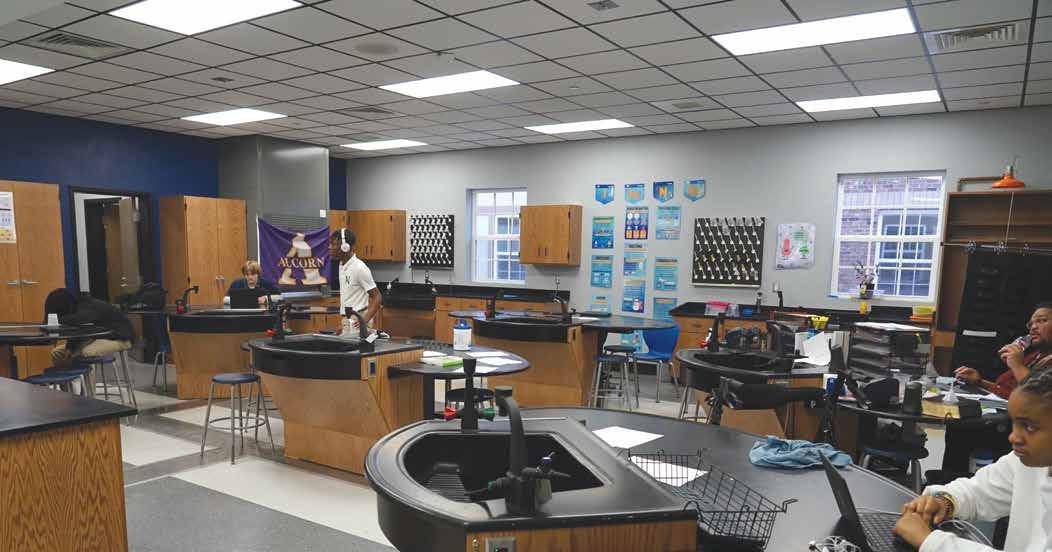
”
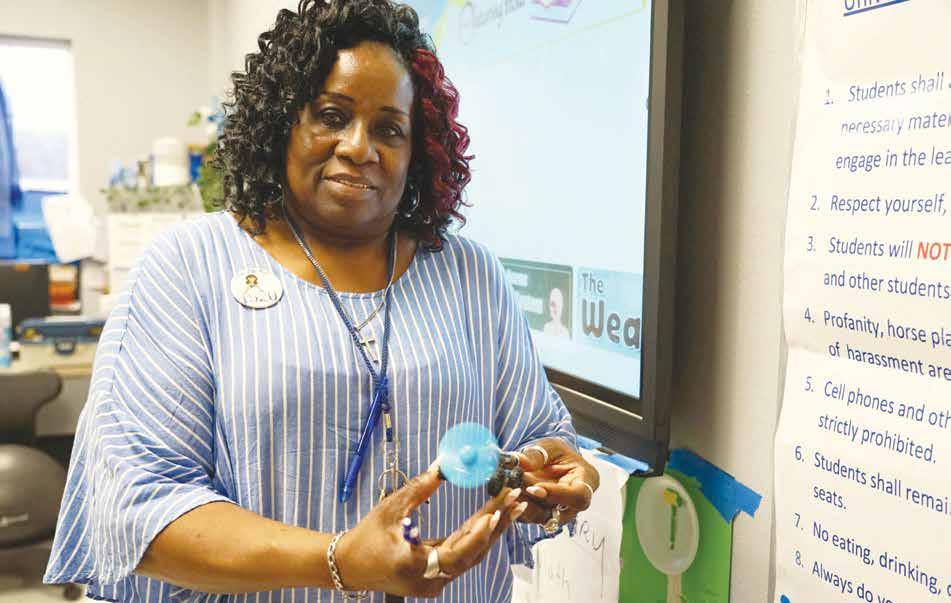
which required her to learn to use design software to edit, layout and publish it, she said.
Nearly gone are the days of hand-written essays and classroom assignments as more and more emphasis is placed on technology use in the classroom, Lee said.
“You're trying to meet the kids where they are, and with the kids being very savvy on their computers with the gaming and things like that gives more chances to do technology-based things — technologically submitting assignments, playing games and building Power Points. There are a number of different ways to get work done versus writing.”
Schools were already turning to more technology use in the classroom before the COVID-19 pandemic forced a move to the classroom online.
“I was teaching every day, seeing the kids every day and then I went to teaching online and that was an adjustment for me as well,” Lee said. “I wasn't used to it. I was the kind of student that needed to be in class, but I had to adjust and because of that, my technology skills enhanced.”
While it wasn’t by choice, Lee said some of the changes brought to in-classroom learning by COVID-19
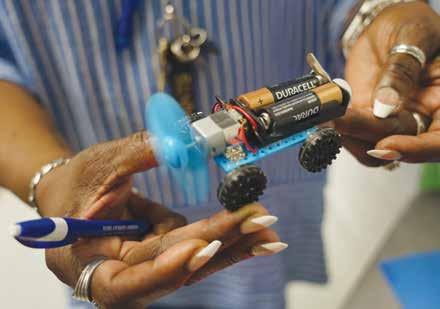
were for the better.
Cutting back on writing time with computer assignments meant more time left for hands-on activities and out-of-classroom experiences.
“We've gone to Grand Gulf this year. We've done Co-Lin’s symposium this year. We've had speakers come in the STEM Academy and now we're trying to partner with Alcorn a little bit by doing some dual chemistry lab assignments,” she said.
Students have set eyes on working men and women, some not much older than they are, doing high-paying jobs and doing well and have been inspired, Lee said.
During their tour of Grand Gulf in Port Gibson, Lee said, “The females got to say ‘Oh wait a minute, there
are other women in engineering too? I might need to look into this.’ And it’s not a boring job and there are all different kinds of jobs they can do ... It opens up their eyes to what they can be able to accomplish.”
The high school, which has four different wings, has a wing dedicated to an academy-like program with individual classrooms dedicated to each focus of STEM.
Each affords students opportunities for hands-on learning.
Eventually, students will start out as freshmen exploring different types of academies, Communication Arts and Business, Health and Human Sciences and STEM, so that once they leave their freshman year, they can enter the academy of their
choice and expand their knowledge in the field they are most interested in, Lee said.
“Right now, we’re just getting started so we see more seniors,” she said. “Some kids will not be able to go to college and they will have to pick up a trade. Here they can get their feet wet for lack of a better term, so they can visit the various careers and can maybe pick up a trade.”
Students who are not sure can take the ACT Work Keys assessment to tell them what area they're most likely to go into, Lee said.
In addition to traditional classes like English, Math, Science and Social Studies, Natchez High School and the Fallin Career Technical Center have classes that teach automotive repair and maintenance, carpentry, public speaking and digital media technology.
They also have classes that teach students other life skills like home economics, early childhood, and driver’s education as well as resume writing and job interview workshops.
“Students have the ability to record their own commercials,” which get published on the school website and social media, Lee said.
Because it is new, Lee said the program is looking for other opportunities to partner with the community and give students more exposure to areas they can work.
BY JAN GRIFFEY | PHOTOS SUBMITTED
Natchez is only beginning to develop and share its rich African American heritage and history with visitors.
While often painful and shameful for the city’s residents, the African Americans who were enslaved in Natchez built the city and shared with all a culture that has made Natchez the diverse community it is today.
Visit Natchez hired Dr. Roscoe Barnes III as cultural heritage tourism manager. Barnes has made significant strides in aiding communication between the city and different groups in the city, as well as working with state organizations to promote African American heritage here.
A major boost in that effort came in 2024 when the city was awarded a $24 mil-
lion-plus federal grant to create the Forks to Freedom corridor, which will link the infamous Forks of the Road slave market with the Hyram Revels Plaza and the proposed location of the U.S. Colored Troops Monument on the Bluff.
The Forks of the Road slave market was located at what today is the intersection of Liberty Road and D’Evereux Drive. In the mid-19th century, it was the second most active slave market in the South.
Just up the road at what is now Dr. Martin Luther King Jr. Street, Hyram Revels was the pastor of Zion Chapel AME Church. Revels would become the country’s first African American member of the U.S. Senate. Led by the Friends of the Riverfront, Zion Chapel Church, the City of Natchez and the Downtown Natchez Al-

liance, work has begun on Hyram Revels plaza and other improvements in the triangle at St. Catherine Street and MLK Street.
Lastly, the community is several years into a project to raise funds for a monument currently raising funds for a monument to honor the U.S. Colored Troops who served in Natchez.
Vicksburg fell on July 4, 1863, and the Union Army took control of the Mississippi River. On July 13, 1863, Union soldiers arrived in Natchez and established a headquarters here. Black Natchezians served in the U.S. Navy and many others joined the Union’s Colored Troops and used timbers from the former slave markets to help create Fort McPherson, which was located at what is now the entrance to the Natchez City Cemetery.
“
The Forks of the Road slave market was located at what today is the intersection of Liberty Road and D’Evereux Drive. In the mid-19th century, it was the second most active slave market in the South.
”
















‘Loving and faithful’ congregation at Grace Methodist celebrates benchmark anniversary
BY STACY GRANING | PHOTOS SUBMITTED
Grace is a theme that runs through the life of the Rev. Creighton White and the church he now pastors.
White has been pastor of Grace Methodist Church since July 2024. In February, he helped the stalwart congregation celebrate a milestone anniversary – 75 years.
Growing up in Moreton, White was active in his Methodist faith. In college at East Central Community College and then at Jackson State University, he served two churches in various ministries – a theme that would recur in his life. Throughout his work career, White found himself serving the church – whether singing in gospel choirs or helping with youth ministry.
He served churches around the state through his adult life, from Pelahatchie to Walnut Grove in Harperville; New Albany to Collins. When God placed the call to the clergy, White answered.
He graduated from the Memphis Theo-
logical Seminary in 2008 and became an elder in the church in 2012. And despite a stroke in 2011 that set him back for several months, White has been a faithful servant for more than 40 years.
“I’d done everything in the church before I became a pastor,” White said.
His wife, Catrina, has been by his side for 42 years, calling it a “blessing” to serve alongside White as “his right-hand man.”
“I love the Lord, and I grew up in the church,” she said.
White is more direct. “The most supportive person I have in my life is my wife. She’s almost more involved in the ministry than I am,” he said with a laugh. “We are truly a team.”
And as a team, they have embraced life at Grace Methodist and Church Hill Methodist, the small country congregation he also pastors.
Grace Methodist was organized in February with 28 charter members. The first
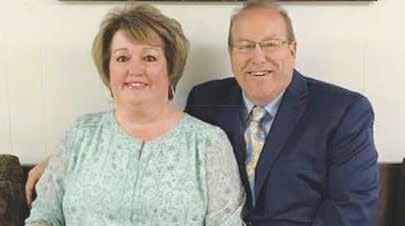

two years the members met at the Cold Storage Building on Liberty Road. On July 1, 1951, a groundbreaking service was held and became the firsts step in building the first steps of the present-day church on land donated by Mrs. Grace M.S. MacNeil.
On March 2, 1952, the first church service was held in the building, which serves as the sanctuary.
In 1955, the second unit of the building was occupied. The third unit was completed in 1960 and the most recent building addition was completed on 1995 and added office, youth and music space.
While Grace is a modest congregation –some 100 members strong – it is a loyal and faith-filled one, White said. “And it’s remarkable that in the last 75 years, they’ve only had 20 ministers and one Diaconal minister,” he added, explaining that the structure of the Methodist Church often results in frequent moves among pastors and clergy.
White himself has moved six times during his pastoral career, often leaving only when the five-year service limit expires.
That continuity is a testament to the faith of both White and the Grace Methodist family.
“I hope I can stay here until I retire,” he said. “This is a good church, good congregation. They do a good amount of mission work and they are loving and faithful. It’s a good team effort.”
At Church Hill, a more rural and even smaller congregation, “the members do a tremendous number of ministries. They are blessed.”
The people are who form the body of Christ at Grace and Church Hill, And everywhere he looks, White sees evidence of the Grace that gives the church its name and its purpose.
“They talk about the love and unity here and it’s been here a long time,” he said.


STORY AND PHOTOS
BY SABRINA ROBERTSON
Skylar Carson, a Concordia Parish Academy Senior, looked up at her peers, directing them from the floor below the stage in the school cafeteria.
They were attempting a dance number with textbooks. The night of the production, the books would be replaced with lunch tray props for a cafeteria scene in Mean Girls Jr.
But for now, they just had to get the movement down.
“Did anyone of you watch High School Musical? The first one?” Carson said. She then hopped up on stage to show them the movement. The students danced in a
circle, forward-facing, while also rotating their textbooks around in a clock-like motion. It took more than a few tries to nail it down, but that is what practice is for.
Once they got the motion right, it was time to queue up the music to get the rhythm.
While the practice was held at CPA, the students came from schools all around the parish to perform in the Concordia Parish Players, a district-wide drama club that was founded last school year.
At that time, the drama club was led by Leigh Ann Mason, who has been involved in local theater as well as with the costume

““This is the first year of an official theater program and class. Last year it was just starting to be built and was more of an afterschool activity. Now we’ve got a program going and momentum building. Any student that attends school in Concordia Parish in the middle and high school level can join.”
— Reagan Fraze

aspect of film productions in the area.
Reagan Fraze took the reins of the club in February 2024, when she came from Texas to teach a theater class at Ferriday, CPA, and Vidalia High schools.
Before she studied musical theater production at Texas Wesleyan in Fort Worth, she grew up in Texas doing theatre competitions where she would perform on stage in one-act plays. When she graduated from college in December 2020, early COVID-19 pandemic, there weren’t a lot of theater productions going on. She wound up becoming a teacher’s aide in a special education class right out of college before coming to Concordia Parish to teach theater.
“Hopefully, it’s going to grow to where I can have more than just one class at each school,” she said of teaching theater in Concordia Parish.
She dived right into her first Concordia Parish Players production, “Sister Act Jr,” in 2024 with only a month to rehearse, she said.
“Maybe just slightly over a month, including auditions,” Fraze said.
The play included youth as young as sixth grade on up to graduating seniors.
“This is the first year of an official theater program and class. Last year it was just starting to be built and was more of an afterschool activity. Now we’ve got a program going and momentum building. Any student that attends school in Concordia Parish in the middle and high school level can join.”
Plays will rotate host schools so that they’re done in each community. Sister Act Jr. was performed in Vidalia, and last fall, “15 Reasons Not to be in a Play” was performed at CPA. Mean Girls Jr. in April 2025 was performed in Ferriday.
The future of Concordia Parish Players is already looking secure in Carson, who plans to study theater at Louisiana State University to become a teacher and continue arts education in Concordia Parish, she said.
“I feel that there is a lot of untapped creative talent here in Concordia Parish,” Carson said.
A lot of talented students in Concordia Parish schools are used to singing in church bands and acting on stage at Natchez Little Theatre. However, they’ve never had an avenue to express their artistic capability in a school-based theatre production until Concordia Parish Players.
“They are so enthusiastic and happy to
have a creative outlet,” Fraze said of her students.
Vincent “Vinny” White Jr., who played Aaron, the love interest in Mean Girls Jr., said he has been involved in theater since 11 or 12 years old. He was first exposed to theatre in NLT performances of The Lion King and The Jungle Book, he said.
He was also involved in a film with Rumble Through the Dark, which was filmed in Natchez, and worked backstage in the Sister Act Jr.
“I think it’s pretty dope,” White said of Concordia Parish Players. “This is probably like my fifth production. ... Through theater, I’ve learned how to be more open with people.”
Britton Whittington, who played Regina George and Deloris in Sister Act Jr., said that theater helped her overcome her fear of being in front of people.
“The school I went to before didn’t have anything like this,” she said. “It’s given me opportunities to do more.”
Whittington added the Concordia Parish Players also opened up the door for her to meet other people. “Some of these people here I’d have never known if it weren’t for theater.”
Theater isn’t just for on-stage talent, either. Fraze said students handle most aspects of a production including costume design, set design, creating publicity posters, controlling light and sound, choreography, assistant directing and stage management.
Students rehearse daily from 4 to 6 p.m. and Fraze works more than that, spending a lot of late nights and early mornings figuring out every detail of a production, such as stage cues — who is going to be standing where and when — and what props and costumes they’ll need.
“Anything that you see on stage is something I had to figure out,” she said.
How can the community support it?
Since the players are still ramping up, they are still collecting a storage closet full of supplies, props and other things to allow future productions, Fraze said. Tools, hardware and lumber are always useful.
But first and foremost, “Come see the show. Show the kids that this is something the community enjoys. Everyone loves it. Sister Act Jr. sold way more tickets than we expected. We had three performances and close to 400 people total attended,” she said.










BY STACY GRANING | PHOTO SUBMITTED
Prince Abdul Rahman Ibrahima (1762-1829) was an African prince who spent 40 years enslaved on a plantation near Natchez before gaining his freedom in 1828.
History tells that Ibrahima was born in Timbuktu and grew up in Timbo, Guinea, West Africa, where his father was king. He served in the military until he was captured and sold to slave traders.
Ibrahima arrived in Natchez in August 1788 and was purchased by a farmer named Thomas Foster. Eventually, he became an overseer at Foster’s plantation and his reputation grew. A Chance meeting with an Irish doctor at a market led to Ibrahima’s identification as a prince and efforts by the doctor to buy the prince’s freedom. When that failed, Andrew Marschalk – known as the Father of Journalism in Mississippi – began a letter writing campaign on Ibrahima’s behalf. In 1828, U.S. Secretary of State Henry Clay granted the prince’s freedom and he and his wife sailed to Liberia in 1829.
The prince’s history in Natchez and the efforts of those who fought for his freedom are being chronicled in a new walking tour developed by Visit Natchez, the Mississippi Humanities Council, Historic Natchez Foundation and the Natchez Museum of African American History and Culture.
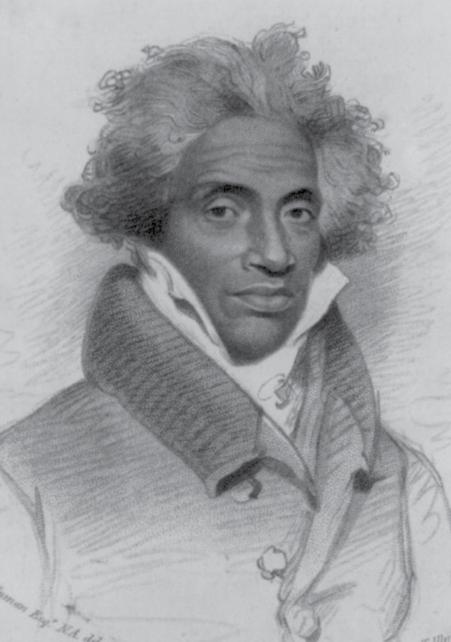


BY SABRINA ROBERTSON | PHOTO SUBMITTED
Concordia Parish Sheriff’s Office has been a trailblazer in terms of how law enforcement investigates domestic and sexual abuse crimes and deals with victims of such crimes.
Since the opening of the Community Justice Center at 27797 Highway 15 in Ferriday in the fall of 2022, the department has helped nearly 500 vulnerable victims through its victim advocacy center. Additionally, the department has arrested more than 100 alleged child predators through its cybercrime and Special Victims Unit housed in the Ferriday facility.
Inspired by a specific child’s story, there is a special soft interview room with comfortable couch seating designed to provide a safe location for helping victims of abuse called “Hope’s Space.”
The facility also houses state-of-the-art technology used to collect evidence from locked electronic devices and identify predators online. CPSO continues to expand with plans to complete a $3 million renovation of an 80-bed facility for 17-year-olds in the criminal justice system in order to meet the growing demand for more juvenile facilities from the State of Louisiana.






























tunities to travel overseas. The past couple of years FBC Vidalia has taken groups to the Dominican Republic to visit different schools and teach and provide for basic needs such as water and food.
They’ve also traveled to London to minister to people vacationing there, from the Middle East and all over the world, he said.
“They hand out free Bibles and they have conversations about what they believe in,” McHalffey said. “That's definitely a really cool experience for them to go and share their faith and also learn about other cultures and what they believe and gives them the opportunity to share the gospel.”
McHalffey said he feels led to student ministry because students between sixth and 12th grade are at a pivotal point in life, where they are deciding who they will be and what they will believe as adults.
“They are building the foundation of what the rest of their life is going to be built on,” he said. “In these in these few years, they are really learning a lot about who they are, who they want to be, how they want to be viewed, so there's all these social pressures from school, parents, family and social media coming at them in from all different directions. ... I get to be there to walk through life with them, encourage them and say ... there is a God that has created you in his image, that you are beautifully and wonderfully made.
“Your identity isn't defined in your academic achievements. It is not defined in your success on the ball field or your popularity or any of those things. You can find your identity in Christ, who loved you enough to go to the cross and die for you to offer etrnal life.”




An acorn doesn’t become a mighty oak overnight, and neither does true expertise. With years of experience transforming landscapes across the Miss-Lou, Live Oak Landscapes delivers results that stand the test of time. When you want your outdoor space to thrive, trust the one who’s been doing it the best and longest, since 1937.













PEARL STREET PASTA –CHEESECAKE
For the best slice of salted caramel drizzled cheesecake, look no further than Pearl Street Pasta. Topped with a few strawberry slices, it’s the perfect dance of tangy, salty and sweet.
MAMMY’S CUPBOARD – PIE
At Mammy’s Cupboard every pie or cake they make fresh daily is a good choice, especially their chocolate or lemon pies piled high with meringue for an excel-
lent Humpday treat.
NATCHEZ COFFEE COMPANY – CINNAMON ROLLS
Start out the day with something sweet at Natchez Coffee Company, which has a plethora of sweet baked goods made daily. Their deliciously sweet cinnamon rolls make the perfect on-the-go breakfast or after meal dessert.
BUTTER CAKERY –BISCOFF CUPCAKE
We can’t talk sweets without giving

mention to Butter Cakery, with multiple flavors of cake, cupcakes, baguettes and more. There really are no bad choices, but their Biscoff cookie butter cakes and cupcakes have the perfect buttery-sweet flavor one might expect from a place called Butter Cakery.
The Malt Shop, with its old-fashioned 50s flair, has become a destination among tourists and locals alike. It also has the best thick sweet malts and shakes and
must-try hot fudge sundaes. There’s nothing quite like the taste of the good old days.
SODA
Basically a desert in a cup, Soda Pop’s Turtle Brownie shake is rich with both brownie batter and vanilla ice cream, caramel and chocolate drizzle and chunks of gooey brownie mixed in topped off with pleasantly crunchy pecan nuts. Also try the strawberry cake ice cream shake, or for a morning pick-me-up, the paparazzi coffee shake









AScottish immigrant, Andrew Brown, arrived in Natchez in the early 1820s and went to work in a sawmill located under the hill in Natchez on the Mississippi riverfront.
Brown, who was trained as an architect in Scotland, soon acquired the sawmill and property in 1828 and built a Greek Revival-style home on the north end of the property, according to the Historic Natchez Foundation.
Magnolia Vale is located precariously close to the Mississippi River. Protected by a berm, it is said that the house has never flooded.
However, it was a spectacular garden that Brown created that would make the property world-famous.
A Natchez newspaper in 1839 described Brown’s gardens at Magnolia Vale as “embosomed like some fairy wrought scene in the Arabian nights,” according to the Historic Natchez Foundation. The writer continued, “farfamed gardens of northern cities would appear tame and lifeless in contrast with Brown’s.”
In 1850, another writer described Brown’s grape arbor as being “ten feet high, eighteen feet wide, and a hundred and thirty feet long,” according to HNF.
Others went on to write that no palace in Europe was as impressive as Brown’s in Natchez.
After a visit to Natchez in 1874,
BY JAN GRIFFEY | PHOTOS SUBMITTED
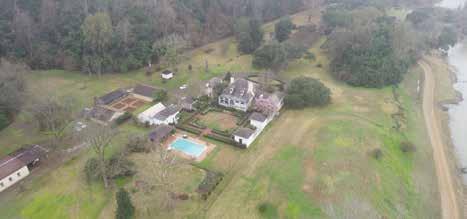
Therese Yelverton, Viscountess of Avonmore, described Brown’s gardens at Magnolia Vale: “In one garden belonging to the Scotchman the roses must have numbered hundreds, and in quantity amounted to many wagon-loads…A pleasanter spot than this Scotchman’s residence can scarcely be imagined or described. Beautifully situated upon the river, every improvement to which art and good taste could suggest had been adopted to increase its natural beauties, and almost every shrub and flower was there to be seen in perfection,” according to HNF.
When Brown died, the property went to his daughter, Elizabeth Brown, who married her stepbrother, Rufus
Learned. It then passed to their son, Andrew Brown Learned and finally to his grandson, Howard Bell Peabody.
In 1946, the original Magnolia Vale burned. Historic Natchez Foundation reports Peabody hired New Orleans architects to design a new home like the original on its same footprint. That home, also known as Magnolia Vale, was completed in 1950. Three pre-Civil War outbuildings at the rear of the house remain.
It was Howard Peabody who bulldozed what was left of Andrew Brown’s worldclass gardens, much to the chagrin of his mother.
“Four original marble statues representing the four seasons still greet visi-
In 1946, the original Magnolia Vale burned. Historic Natchez Foundation reports Peabody hired New Orleans architects to design a new home like the original on its same footprint. That home, also known as Magnolia Vale, was completed in 1950. Three pre-Civil War outbuildings at the rear of the house remain.
tors at the walk leading to the entrance steps, just as they did in the nineteenth century,” Historic Natchez Foundation writes on its website.
The Peabody family owned the home and property until selling it to David Paradise in the 1990s.
Today, the home is owned by husband and wife, Ken Kochey and Sarah Laird.
















DETAIL PACKAGES STARTING AT $60.00

- WASH & VAC
- INTERIOR DETAIL
- EXTERIOR DETAIL
- POLISH & BUFF
- CERAMIC COATING
- PROGRESSIVE GUARANTEED REPAIR NETWORK
- STATE FARM SELECT REPAIR SHOP
- LIFETIME GUARANTEE ON REPAIRS
- DEDUCTIBLE PAYMENT PLANS
- CLAIM ASSISTANCE
- ON-SITE RENTALS




14,000 SQ FT EXPANSION

Wildlife photographer documents area’s creatures




One hardly would believe when looking at Deborah Dickinson’s crisp, stunning wildlife photography that she first picked up a camera only six years ago.
Dickinson is a modern Renaissance woman. Her interests are many and she is self-taught in each of her pursuits, from wildlife photography to woodworking. There is no half-way for Dickinson in anything she does.
“Many people don’t realize all the wildlife we have here. I didn’t realize until I started doing photography all the wildlife that live or pass through our area,” Dickinson said. “I surely wasn’t going to see it sitting on the couch. You’ve got to get out of the house.”


Indeed, the Miss-Lou is home to abundant wildlife, and by now, Dickinson has seen it all.
“My favorite place is the St. Catherine Creek Wildlife Refuge. There’s just a lot out there,” she said.
In recent years, she has seen the amount of wildlife there ebb and flow according to the amount of water there.
“Some of it may have to do with the drought we’ve had, but I don’t see nearly the wildlife I used to. Even the bears. I didn’t see as many this year as I normally do, though it does seem to be getting better,” Dickinson said.
Her home backs up to the St. Cath-
erine Creek. “I see lots of wildlife right on my property.
“The St. Catherine Creek Wildlife Refuge is a gorgeous place. People should go there. It’s incredible.”
Dickinson and her faithful German Shepherd, Cowboy, climb into her Jeep and take to the backroads to find animals to photograph.
“I love the lakes, too. I like to kayak and take pictures from the kayak.
Animals don’t seem to be as afraid of you when you photograph them from the water. I’ve seen deer on the bank almost come right to the kayak,” she said. Lake St. John is a favorite place






for photography.
Bears are her favorite animal to photograph. After having photographed hundreds of bears in the area, she said she was only frightened once.
“I had Cowboy with me and we got out of the Jeep and I was walking him. I had gotten him back in the back of the Jeep and I was giving him water when I noticed a huge bear standing up looking at me. He looked like he was seven feet tall. I think he was just as surprised to see me as I was to see him,” she said. “I’m not normally scared, but that made me a little frightened.”
She said the bear got down from a standing position and began to walk away.
“I ran to the front of the car to get my camera and he was back and stood up again. I was able to get a picture. He had beggar lice all over him,” Dickinson said. “Thankfully, Cowboy did not see him.”
Among her favorite photos are those of not-often-seen birds and the like.
“The painted buntings are among my favorites. Merlin. Some of the water thrusts. And the eagles. I have people on Facebook who argue with me telling me there are no eagles in the Natchez area. I’ve seen them at the port and the lakes and the wildlife refuge. I don’t argue with them. I just keep taking photos,” Dickinson said.
““I had Cowboy with me and we got out of the Jeep and I was walking him. I had gotten him back in the back of the Jeep and I was giving him water when I noticed a huge bear standing
up looking
at me. He looked like he was seven feet tall. I think he was just as surprised to see me as I was to see him. I’m not normally scared, but that made me a little frightened.”
— Deborah Dickinson
BY STACY GRANING | PHOTO SUBMITTED
In 1861, the Brothers of the Sacred Heart began educating boys in Natchez. Among those were the orphans who were housed at Devereux Hall, run by the Brothers and housed at a building donated by William St. John Elliott. at Cathedral School.
The school first met in a mansion willed to the Brothers by William St. John Elliot. Over the next 105 years, that building was home to more than 1,500 boys, all of whom were educated and housed by the brothers.
James Shaidnagle was one of those boys, coming to Devereux Hall in 1955 and graduating from Cathedral School in 1962.
His life came full circle when Shaidnagle returned to Natchez to
teach at Cathedral until his retirement in 2022. In 2023, his appreciation for the Brothers’ role in his life was solidified as he watched a new historic marker be placed at the site of the former orphan asylum that provided the foundation for today’s Cathedral School.
Securing of the marker was made possible with the support of the Historic Natchez Foundation and the Mississippi Department of Archives and History.
“I lived there for six-and-a-half years,” he said this week. “And I wouldn’t be here today if I hadn’t been there … the Brothers (of the Sacred Heart) taught me everything, from work ethic to what’s important in life.”

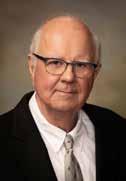





Honoring the lasting impact of Devereux Hall on educationin Natchez

































SABRINA ROBERTSON
Natchez is well-known for its rich history and a plethora of great stories to tell. The Natchez City Cemetery is a quiet place for walking and leisure as well as a place for mourning and a final resting place for many with odd, unique and interesting stories to share from beyond the grave.
Some headstones are straightforward so that multiple generations may know who rests there while others leave room for speculation.
Kerry Dicks grew up playing among
the graves and, as she got older, learned their stories so that she could share them on tours of the cemetery.
Dicks said she finds some humor in the unexpected stories.
An unusual, above-ground grave belongs to Ruphus E. Case who wanted to be buried in his rocking chair beside his daughter who died before him, facing his home state of Louisiana.
To accommodate his wishes, a brick structure was built around Case sitting in his chair next to the child's grave.
Though one might imagine an older man who wanted to be buried in a rocking chair, Case died at 34 years old.
Many stories are told with symbols, like the ones on the beautiful memorial belonging to Paul Salvo from Trapani, Sicily, “erected by his grateful children,” according to the stone.
“Symbols tell a quiet story themselves,” Dicks said. “For instance, a weeping willow symbolizes sorrow and mourning. Flames upside down symbolizes a life extinguished.”




5 years and 2
and 18
Standing prominently on top of Salvo’s grave is a Statue of Hope, a woman with one arm resting on an anchor. She wears a mournful face while her opposite hand drops flowers, a symbol of mortality. The base of the statue contains more symbols. A broken castle on one side also signifies a life cut short. On the other side is the Trinacria, the symbol of Sicily with Medusa's head and three bent legs. The Salvo family immigrated to the United States in 1873, initially arriving in New York, and finally settling in Natchez in 1876. An experienced seaman, Salvo transported spices on three small to medium-sized ships and held a Royal Italian maritime license. Then there is a Christian symbol of a lion holding a cross which signifies strength, faith and hope for eternal life.
Some grave symbols define one’s heritage or ethnicity.
There was a peak in the population of Jewish families in Natchez around the 1840s and then a decline during the Great Depression. Today, there are probably fewer than 10 Jewish families still left in Natchez but a few thousand Jewish graves in the Natchez City Cemetery found within three Jewish lots, Dicks said.
These are distinctly marked, some with scroll-shaped headstones and Hebrew writing. A few have the hand gesture that, thanks to Jewish actor Leonard Nimoy, later became the famous Vulcan salute in Star Trek.
What is fascinating to Dicks about the Jewish graves is their proud history. “A lot of them tell where they were born,” she said. “I love the idea of tombstones here that tell full stories.”
The Heiber family memorial, for example, lists generations who died in Auschwitz in the Holocaust.
“A lot traveled or were pushed so far from home that there was this desire to preserve their ancestry at the end of life. They felt the need to do that on their graves and put the whole story on there so that people would know it,” Dicks said.
Perhaps the most sorrowful stories come from those with very short lives, like the grave with the sleeping statue of baby Fred-

rick Grone, who “departed this life April 8, 1861, aged 5 years, two months and 18 days.”
The family stone of Joseph Eisely tells of his lonely life after he lost his wife Mary Susan at the age of 29 and their five children between the ages of 12 and infancy “who all died within one week of yellow fever” in Vidalia, La. in September of 1853. Joseph Eisely, who seems to have never remarried, died 39 years later and was buried with them.
The grave of the famous Bud Scott, who was born a slave and became a renowned jazz musician, has a single musical note engraved on the back of the headstone. It’s been said that during the prohibition era, he would sit out on his porch and play Natchez Police Chief Mike Ryan’s favorite song “My Wild Irish Rose” whenever he saw him coming. Some say it was because of his fondness for the police chief that he always played for him, and perhaps Ryan took it as a compliment. Unbeknownst to him, the song could have also been a warning to anyone close enough to hear that they needed to hide their liquor.
Often the size and material used to make the grave was a quiet way to boast of someone’s wealth, Dicks said.
“Graves are expensive, so getting someone to professionally carve your stone was a lot,” she said. Unfortunately, many stories go untold. Those who were enslaved or who were very poor had graves made of wood and there is nothing left to tell those stories.
Then there are odd little graves, like one that simply says, “Louise. The Unfortunate.” Nobody knows Louise’s last name, where she came from, or what her story was, though Dicks’ speculation is that she may have been a waitress or a prostitute who frequented Natchez-Under-The-Hill. Some say she came to Natchez by steamboat to find her fiancée and apparently never did. However, she must have gained someone’s love or attention — someone with wealth or importance because they paid for her funeral and her headstone. Although, it tells us little about her story, not even when she died; only that she was unfortunate.




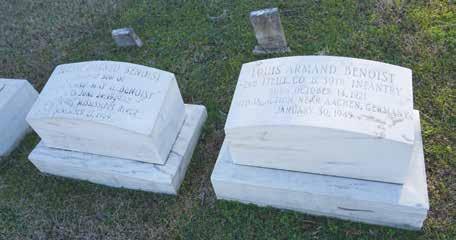

Compassion to give back to the communities we serve ows through the heart and soul of Atmos Energy’s employees. We are committed to helping students have a bright and healthy future by ghting childhood hunger and focusing on reading on level by 3rd grade, showing appreciation to our hometown heroes and providing assistance to our neighbors in need. We are proud to play a vital role in the communities we serve with our time, talent and resources.

Natchez Railway revitalization hailed as ‘gold standard’
More than 100 years ago, the New Orleans & Northwestern Railroad and the Mississippi Central Railroad both ran through southwest Mississippi.
Through mergers and purchases, the lines eventually became part of the Canadian National Railway and provided a 65-mile rail line running from the port at Natchez to Brookhaven, a major CN interchange.
The only east-west railway in Southwest Mississippi carried forestry products, petroleum products – even empty railroad cars headed for repairs in Bude – before dwindling in its usage and viability.
With the rail line in danger of being shut down in 2009, Natchez Inc. spear-
headed a $16 million public-private project to rehabilitate the railroad line. New owners, A&K Railroad Materials Inc., have invested millions of dollars into the line and reopened the railway in March 2022.
In late 2024, the owners secured a $7.7 million grant and promised another $2.3 million investment to add more improvements for safety and freight capacity.
Now, the Natchez Railway is hailed as a “gold standard” of short-line railways.
And Kellen Desmond, president of A&K Railroad Materials Inc., has promised to continue to grow the line. “We’re committed to seeing that railway thrive once again and seeing new opportunities for the Natchez community and the railway.”
THE
Here’s some of the top refreshing drinks, cocktails and mocktails in the Miss-Lou
PEARL STREET PASTA – RASPBERRY PROSECCO COCKTAIL
Made with premium LaMarca Prosecco sparkling wine, vibrant Giffard Framboise, and fresh lemon juice to add a zesty twist to your day.
While flavorful beverages are always fun, sometimes you just need to sip a simple and satisfying cold brew. For a light and pleasantly bubbly ale, we recommend Natchez Brewing Company’s classic Bluff City Blonde. For those in the party who need a little extra, the Brewing Company has an always changing menu of different flavor beers and malts to try out each season of the year.
Cool, crisp and refreshing, the cucumber martini blends smooth vodka with fresh cucumber and a hint of citrus for a light, elegant sip.
BOWIE’S RABBIT HOLE – NATCHEZ LEMONADE
This lemonade, made in-house, is
a refreshing combination of Tito’s Handmade Vodka, blueberry and jalapeno syrup.
Next is actually three drinks. On the left is the Porch Punch –OJ, pineapple, vodka, rum, triple sec, grenadine. On the right is the River Rocker – pineapple, cranberry, Rum Haven coconut rum, vodka, peach schnapps, grenadine. Order both and put the two together and you have the Porch Rocker!
Booze up your brunch with this fruity island cocktail comprised of Malibu and Captain Morgan rum, orange juice, pineapple juice and grenadine topped with an orange slice and maraschino cherry. It’s like paradise in a glass.
Not your ordinary Bloody Mary, Under-the-Hill Saloon spices things up with its own secret homemade Bloody Mary mix topped off with pickled Spanish Queen olives and okra.



STORY BY JAN GRIFFEY PHOTOS COURTESY HISTORIC NATCHEZ FOUNDATION
Natchez is Natchez because of the Mississippi River.
Natchez is the brightest light on the highest point on the entire Mississippi River because of its location.
When the French arrived in approximately 1716, they chose the site because of its location on the Mississippi River.
Transportation for residents and those doing business here has always centered around the Mississippi River.
Today, the river remains an active port city
for those moving goods in and out of the area.
In the early years, ferries moved people, cars, trucks and even trains filled with goods across the river.
Today, two two-lane bridges take care of that task.
While state and federal highways bring people in and out of the city, what we do not have is an interstate highway running through the city.
Many bemoan that fact, saying without an interstate, our city will not grow economically.
“I’ve been thankful every day I have lived here that the interstate bypassed Natchez. I thank God every night for it. If we had not been bypassed, we would be nothing today.”

— Mimi Miller, executive director emerita of the Historic Natchez Foundation
”
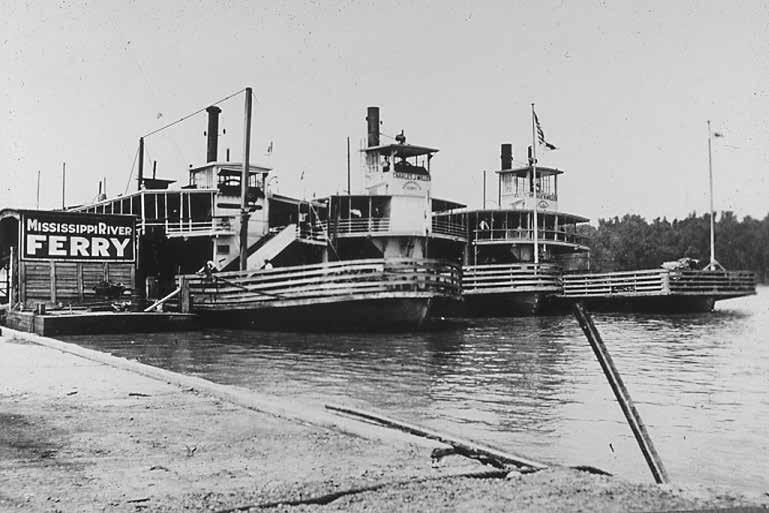




That’s just fine with at least one Natchez resident.
“I’ve been thankful every day I have lived here that the interstate bypassed Natchez,” said Mimi Miller, executive director emerita of the Historic Natchez Foundation. “I thank God every night for it. If we had not been bypassed, we would be nothing today.”
She points to the cities of Vicksburg and Hattiesburg as evidence of what can happen locally when an interstate comes through, disrupting the flow of traffic into a city.
“From a preservation standpoint, land use planning is everything,” Miller said.
Natchez was one of the oldest cities to enact zoning ordinances in the state.
Arch Winter, who was the city planner in Mobile, Alabama, was hired to consult with the city’s first city zoning plan.
“Hattiesburg had a great street with great things that was the major access road to downtown,” she said. “When the interstate came through, they just tore it all down. It really hurt their downtown. “In all honesty, Arch Winter saved Homochitto Street.”
Getting to Natchez is still challenging, many agree. However, the city and county are at work trying to entice a commercial airline to aid those who want to begin and end their river cruise vacations here. And preliminary plans are under way to add to the interstate highway system via the creation of Interstate 14, though that plan is likely many years away should it come to fruition.
BY STACY GRANING | HISTORIC PHOTO COURTESY THE TOM AND JOAN GANDY COLLECTION
hat was once one of the rowdiest ports of the Mississippi River is now home to one of the most iconic and unique historical sites in America.
Since the late 1700s, Natchez Underthe-Hill has been the gateway for river travelers into Natchez. In the 1800s, the area was described by numerous nineteenth-century travelers as one of the rowdiest ports on the Mississippi River. The docks were home to keelboats and flatboats and, starting in 1811, America’s iconic steamboats.
The principal street – now known as Silver Street – was flanked by taverns, gambling halls and brothels. As one saying goes, the only thing cheaper there than the body of a woman was the life of a man, and Under-the-Hill was a community entirely separate from Natchez “on top of the hill.”
In the late 1900s, D.A. Biglane led ef-
forts to restore and preserve Natchez Under-the-Hill, which today boasts robust restaurants; a world-famous saloon; guest suites; retail establishments; and a spot on the U.S. Register of National Historic Places.,
Gail Guido, a relative of Biglane’s, has lived Under-the-Hill for 15 years and owned a retail shop there for 10 of those years.
“There’s nothing prettier than that view,” she said, referring to the Mississippi River which rolls by just feet from her shop.
“There are definitely advantages and disadvantages, but the advantages far outweigh the others.”
And she wants to do more to continue to preserve and embrace the past for the future and for visitors. “My next dream is to have some sort of space down here that talks about the history of Natchez Under-the-Hill,” she said.

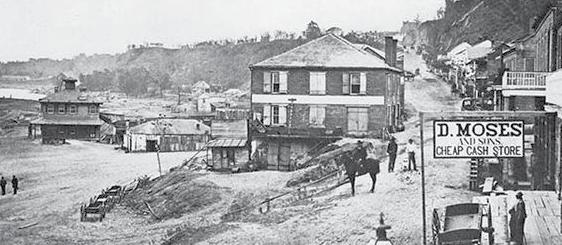




Adams
County Christian School
Assistant Football
Coach Rudy Wilson, a volunteer coach of Adams County Christian School’s football team, has a deep love for the sport that keeps him coming back to games and practices six days a week.
“If it ever gets to the point where I don’t get the butterflies before the game ... that’s when I’ll quit.
Wilson has been on the sidelines of 10 championship games, including six that were won.
He started coaching right alongside head coach David King, coming from the former Trinity Episcopal School to ACCS.
“It makes me feel old when I think of how I’ve been doing it but it’s been joyful,” he said.
A proud moment for Wilson, too, was seeing King get inducted into the MAIS Sports Hall of Fame in 2024. “I have been walking the sidelines for pretty much his whole career. ... It’s an honor to be associated with someone like that.”
BY SABRINA ROBERTSON | PHOTO BY SABRINA ROBERTSON
Wilson’s coaching resume started in 1992 when his oldest son was 5 or 6 years old and started playing Dixie Youth T-ball, he said. He later coached his younger son, then coached softball for his daughter and his niece. Around 1998, Wilson and friends started an Athletic Youth Academy football and basketball league, which he still oversees today but is coached by other volunteers.
“I don’t actually run everything like I used to,” he said. “It used to be that I was up at the basketball gym at 6 a.m. to 9 p.m.”
When Wilson’s sons were in junior high school and started playing football is when he started volunteering to coach and didn’t stop, not even after they graduated.
“At one time, I actually coached an AYA team, a junior high team and a high school team. Thursday nights we had a JV game, a high school came Friday nights and then on Saturday had AYA games all day,” all while still working a
day job and coaching at practices most evenings during the week, he said.
“Every spring and summer for 27 years straight, I coached either softball, baseball or something and then coached football all during the fall. High school football is the only thing I coach now as my kids are grown up.”
Brandyn Wilson, his wife, joked about never getting to see him much except out on the field from the stadium.
For his day job, Wilson runs Winnwood Forest Products in Natchez and Gloster. Before that he worked for an insurance company for 25 years.
“Brandyn likes to say I had a mid-life crisis, but instead of buying a motorcycle, I bought a log truck. I worked for myself for years hauling logs out of the woods,” he said.
As a teenager, Wilson played tight end and defensive end at South Natchez High School. “Back then, everyone called me Rocky,” because with darker hair he resembled a young Sylvester Stallone.
Coach's love of the sport keeps him coming back
“Some didn’t even know my name was Rudy.”
Throughout his coaching career, Wilson has stood by King through remarkable undefeated seasons and watched players bounce back from defeat. One of the biggest comebacks Wilson remembers is having to forfeit the first seven games of a season because of a technicality yet still managing to enter the playoffs as a 14th seed and win a championship.
“I’ve got six championship rings in there, but I can’t say I’ve ever had any one of them on my fingers,” he said. “Wins and losses — they all matter.”
Wilson said that while winning a state championship is always a goal to strive for, coaching for him is about reaching the players and molding them to play as a team.
“Anyone can coach a great athlete, but if you can take an average or not so athletically gifted child and get them to perform at a higher level, that is more rewarding,” he said.













SBY STACY GRANING
PHOTO SUBMITTED
outhern hospitality dictates that we take a moment to get to know our guests, and one of the most common phrases heard throughout the Miss-Lou is “where y’all from?”
In 2023, nearly a million tourists came to Natchez, creating $100 million in economic impact and close to 1,800 jobs –from service sector to business owner.
And those visitors help make Natchez, Natchez the top performing tourism destination of any small city in our region.
And where are they all from? Maps at places like Wardo’s Po-Boys and Natchez Coffee Company offer a quick visual clue, and you’ll never know what you’ll find when you ask, “where y’all from?”










STORY BY JAN GRIFFEY | PHOTOS SUBMITTED
Julianna Wallace Rabb considers herself a micro-influencer.
She’s not on the level of Mississippi Kween, Shoelover99 or YourBarefootNeighbor, but that’s also not her goal.
“I’m more of a local influencer, but I have a wonderful fan base and I enjoy talking to all of my followers,” she said.
Rabb is a biomedical engineer-turned-social media influencer and marketer. She’s out to promote Natchez and help promote Miss-Lou businesses on social media.
“I love promoting Natchez and our small-town, southern lifestyle. I love our way of life here,” she said.
Rabb graduated from Adams County Christian School in 2014 and headed to Mississippi State University, where she earned her engineering degree in 2019. She went to work in biomedical engineering in Tuscaloosa, Alabama.
“I never thought I would be able to move back to Natchez,” she said. However, she got a job as the biomedical engineer at Merit Health Natchez.
“When I moved back to Natchez, I started fresh. I created a new Instagram account and began documenting my life. That was right before COVID. I was just trying to romanticize my life a little bit,” Rabb said. “I would make myself a huge breakfast and use fine china. I needed to keep busy with that kind of thing because there was no socializing. I would pack a beautiful picnic and document that on Instagram.
“When people started coming back into businesses, I would go around talking to everyone and post those things,” she said.
Promoting Natchez became her passion.
“I would go to these other places for weekends or on vacation and think about how much more Natchez has to offer, so I just try to ex-
““I
love it. I’ve learned so much about different industries and I keep expanding my skill set. I love to try new things, and this work allows me to do that. I had somebody ask me how I could go from being an engineer to social media. For one, I’m very technically minded. It’s easy for me to do this job, which is very technical. I’ve had to learn to use lots of software. It’s actually a perfect fit for me.
— Julianna Wallace Rabb
pand its digital footprint,” Rabb said.
A few years ago, people who owned businesses began asking her to do their social media postings. She began doing that, while continuing to work at Merit Health Natchez.
Rabb met her husband, Michael, in July 2023 and the two married in April 2024.
Soon, Rabb found herself in the position of having to turn business away because she could not handle more social media work while continuing her engineering job.
In August 2024, she left her fulltime job and began solely doing marketing for local businesses.
“I was terrified, but I reached the point where I chose to go full force ahead with the marketing and take on new clients,” she said. “I knew it was the right decision almost immediately. We are planning to start a family soon, and the social media work lets me have the flexibility I will need when we have a family.”
Most important, she said she enjoys the work and continues to learn in the process.
“I love it. I’ve learned so much about different industries and I keep expanding my skill set. I love to try new things, and this work

allows me to do that,” she said. “I had somebody ask me how I could go from being an engineer to social media. For one, I’m very technically minded. It’s easy for me to do this job, which is very technical. I’ve had to learn to use lots of software. It’s actually a perfect fit for me.
“In college, you think you have this whole plan for your life and how it is going to happen. Then you realized you want so much more. There’s so much more to like and more things that you want to do.”
Rabb is also the outreach coordinator for Natchez Children’s Services. She plans events for them and handles their social media.
“I love people. I could talk to a post. Ultimately, I started this to help people. Running a social media account, to do it right, is a full time job. This is one thing I can take off of a business owner’s plate. People can trust me to portray their business in the way they want it to be seen.
“Ultimately it comes down to the fact that I love the Miss-Lou so much and we deserve to be in the spotlight,” Rabb said.
You can find Rabb on Facebook, Instagram and TikTok at @MakeLifeJuicyy.
Rene Adams laughs with a patient at Merit Health Natchez. Below, Rene Adams enters patient information into a computer.

STORY BY JAN GRIFFEY| SUBMITTED PHOTOS
At age 55, Rene Adams took a life-changing leap of faith, and it has paid off in the most spectacular of ways.
That leap required years of hard work, battling doubts and finding the fortitude to carry on. It also took the support of many who propped her up and encouraged her during the tough days of her journey and as important, cheered her successes.
Most in Natchez know Adams from her many years spent in the hospitality industry. She has owned Natchez restaurants, most recently the popular Rolling River on Main Street.
They know her also for her trademark bright smile and infectious enthusiasm.
Her catering business has delighted many for years, including Dickie Brennan of the famed New Orleans restaurant family. Mayor
Dan Gibson called on Adams to create a dinner worthy of Brennan when he hosted him here for the first time.
Just before COVID hit, Adams’ brother, Richard, was diagnosed with esophageal cancer, and she became his caregiver.
“He worried about me,” she said. “He told me I needed to go to nursing school. I asked him, ‘Are you trying to say I’ve done a good job taking care of you?’ He said yes, but told me I needed a career I could depend on and that I was good at caring for people. I asked him, how do you stop your life and go to nursing school?
‘We are going to figure this out,’ he said.”
She shed tears telling the story. “I don’t know why I’m crying. It’s all coming back to me.”
Not long afterward, Richard lost his battle

with cancer.
“His was the last public funeral before COVID,” Adams said.
When COVID hit, Adams’ life came crashing down around her, like it did for many.
“I had lost the restaurant on Main Street and was working for the Mississippi Restaurant Association, and that job came to an end,” she said.
Also, Adams and her long-time love, Margaret Perkins, after having been on a break of sorts, were just getting back together. The two were married in 2022.
“I owed a lot of money from the restaurant and I worried constantly about how I was going to take care of myself and how I was going to pay my bills,” Adams said. “I kept coming back to, ‘You’re going to nursing school.’
“I called Marla Farmer and asked her if I had lost my mind,” Adams said. Farmer, a lifelong friend, taught in the Alcorn State University School of Nursing. “She told me, ‘No! Absolutely not. You will make a tremendous nurse.‘ “
Next, Nancy McFarland, who was working at Co-Lin at the time, stepped up to help Adams.
“She put everything together for me. She changed my life,” Adams said. “She mapped out three plans. ‘You can do this. I’m going to enroll you in the summer so you can take a class and get used to being back in school. Then you will do this, then that.’ She took care of everything.”
From there, many other details fell
into place.
“I graduated from Trinity in 1984. How do I get my records? The school closed. I didn’t know that when a school closes, all the records go to the district’s public schools. I thought that was going to be difficult to get, but I called and the woman who answered had them all ready the next day,” she said. “Everything just came together.”
Instead of being difficult to get back into the routine of going to class, Adams was a natural.
“I loved it! I loved learning!”
However, taking college classes was much different than when she was a student at Delta State in the mid-1980s.
“The technology was so different. And I was the oldest person in my classes,” she said.
Younger classmates, like Katie Cloy and Bailey Warden and others, stepped in to help every time Adams stumbled with a technology issue.
Getting into the habit of studying again after so many years was indeed difficult, but she pushed through and developed her own study habits.
“My dad had the chemistry brain,” Adams said. Her father is the legendary Natchez athlete and football coach, the late Clyde Adams.
In a chair that belonged to her father, she would have intense study sessions.
“I would crawl up in daddy’s chair at 3 a.m. and talk to him,” asking him to give her the knowledge she needed. “I would tell him, ‘Come on. Give it to
me.’ I would take a nap, then wake up and go at it again,” she said. “And I felt my brother the whole time.”
Indeed it took a village worth of support and encouragement to get her through nursing school, Adams said.
“I would not have been able to do this without the support of my wife, Margaret. Period,” she said. “I got so much encouragement, from Margaret and from everyone, even Henry the Walmart greeter. I was still catering while I was in nursing school and would go in to Walmart on Fridays after class to get what I needed. Henry would call out, ‘There’s my nurse! You keep going!’ “
After nursing school, Adams next hurdle was passing the NCLEX, the National Council Licensure Examination, the standardized test registered nurses must take to ensure they are ready to practice.
Adams passed. “If I hadn’t passed it, they would have had to take me to Laird’s in a body bag,” she said.
As a registered nurse, Adams had lots of opportunities for work. However, Merit Health Natchez — the former Jefferson Davis Memorial Hospital where Adams was born and former Natchez Regional Medical Center — is as much a part of Adams’ life as is the Natchez community itself.
Today, Adams is a nurse on the medical/surgical floor at Merit Health.
“When I walk the halls of this hospi-
tal, I think of all the amazing people who also walked these halls. Dr. (John) Young, Dr. (Bruce) Kuehnle. And what it has meant to my family. My brother, my grandmothers…Working here feels right,” she said. “I am connected to this place.”
Adams tried to name all of the hospital staffers who have helped her since becoming a nurse — Vanessa Piper, Kay Ketchings, Lee Hinson, Cicely Ishman, Chris Newman, Patricia Marks, Tammy Cranford, but she could not name them all.
“It is an honor to work with the people I do,” she said. “Everyone has been so kind. Everyone works so hard and are so knowledgeable. You know, people love to hate on their local hospital. I can tell you the culture that the new CEO (Kevin Samrow) and the people underneath him have put in place is starting to change things here. We are starting to hear a lot of positive feedback.
“I am enjoying just going to work and having a job. I am so grateful that God allowed me to redo myself and I am so grateful to have a hospital that supports it,” Adams said. “I love it. I love every bit of it. And I love the people I work with. I have such respect for those who are there.
“And I am so thankful for everyone who supported me, from my wife to Sara Beth Willard to Henry at Walmart. Nursing is not for the faint of heart. It’s the hardest job I’ve ever had in my life. But I love the art and I love the challenge.”


STORY BY SABRINA ROBERTSON | PHOTOS SUBMITTED AND BY SABRINA ROBERTSON
Some people in the Miss-Lou have taken on an active lifestyle for the sake of enjoyment while others have out of necessity and in doing so found new passion for it.
Sabrina Doré has always been active in the sense that she has supported her community in multiple ways, whether it's by fundraising for the annual fireworks on the Mississippi River on New Year’s Eve and Fourth of July or by decorating flower beds, light poles and hosting fundraising events for the Vidalia Beautification Committee.
A Vidalia native, Doré graduated from Vidalia High School where she was not a girly girl by any means. “I wanted to play football,” she said, adding she settled for being the Vidalia Viking's first
water girl.
Many know from Shelter Insurance, where she has worked for 25 years in the agency and 10 years as an agent helping people protect their valuable property from tragedy.
Her husband Tab Doré got her involved in the Vidalia Beautification Committee in 2016, when she further became a public servant on the Vidalia Board of Aldermen. “I enjoy working with the public,” Doré said.
Since then, she has served her community in many other ways, volunteering for the annual Brightest Stars Ball, Mardi Gras parade and often “jumping in wherever I see a need, even if it’s under the radar,” she said.
A natural “foodie” Doré said she also holds passion for southern cooking and often prepares


meals to feed church parishioners every month at St. Mary Basilica and for her community.
In 2022, Doré also found another unexpected talent for creating TikTok videos, where she posts funnies for fun, home and food tips and also comments on important things happening in the community. She currently has over 500,000 followers and over 11 million likes on TikTok.
After surviving two strokes and a heart attack at age 43, Doré said she began to embrace new hobbies. She and her husband Tab together now enjoy being outdoors.
Their family has often enjoyed traveling small distances to the mountains or the beach, but where they previously incorporated dining at different places into their travels, they now discover new hiking trails and camping grounds, she said.
Their eldest son John Garrett graduated with his master’s degree from Louisiana State University and now teaches mathematics in Thailand and their youngest, Jackson, is a 4th-grade student at Cathedral, she said.
“Tab and I are both very healthy and blessed,” Doré said. “Life is precious.”
Another who finds great enjoyment in life is Brent Bourland, a lawyer of age 75 who considers himself too young to retire, he said. Instead, he is on “spring break,” still working on small law projects every so often that he can finish in a short amount of time.
He fills a lot of his spare time doing an activity he loves — sailing.
“Sailing is my primary hobby,” which he learned to do as a teenager on weekends and holidays spent on Lake St. John, he said. “There were some doctors who had small sailboats and they let us high schoolers use them.”
A native Natchezian, Bourland attended middle school at Cathedral and then attended Natchez High School, where he graduated in 1967.
When Bourland was in college at Ole Miss, and had the time to do so, he would often go sailing with the Peabody family in places like the Virgin Islands and the Bahamas. Later on, Bourland’s brother bought a sailboat that the two of them would sail in the Caribbean each winter, he said.
About 10 years ago, he bought a sailboat of his own, a classic Beneteau 38 that he calls “The Natchez.” The name honors not only the City of Natchez but also the U.S. naval ships that were also called Natchez.
“It’s a historied name,” Bourland said.
The Natchez sailboat now lives at Bucktown Marina on Lake Pontchartrain.
“I spend most every warm weekend on my boat. I’ll go on Friday and come back on Monday.”
““That was an exciting sevenmonth bicycle show. Every night we’d put up little tents and break them down the next day, over and over and just kept on riding. ... Best shape I’ve ever been in my life. You get to a point where you are pedaling the bike and you honestly don’t realize you’re pedaling it.”
— Brent Bourland
”Bourland said. One thing Bourland hasn’t done is competition sailing. “I don’t like to be yelled at,” he said. But that isn’t to say he hasn’t enjoyed longer sailing journeys.
“Sailing a small boat in the middle of the night in the ocean is probably one of the most exciting things I’ve ever done,” he said. “It gets really intense. When it gets dark it’s, like the boat becomes smaller and smaller until it feels tiny, but there’s no stopping. You just keep going.”
Bourland also enjoys bicycling.
He and a friend once took tents and bicycles on a backpacking journey all across Europe, starting in Portugal and then on to Spain, through the Pyrenees mountains to France, then to Amsterdam, Switzerland and Italy, he said.
“That was an exciting seven-month bicycle show,” he said. “Every night we’d put up little tents and break them down the next day, over and over and just kept on riding. ... Best shape I’ve ever been in my life. You get to a point where you are pedaling the bike and you honestly don’t realize you’re pedaling it.”
Among Bourland’s many hobbies is making regular trips to the gym, which he does twice a day every day just to stave off aging, he said. He has always led an active lifestyle. Bourland played competitive tennis in high school and continued to play for 20 or so years after that, he said.
After each of his adventures, he always returns home to Natchez for a reason, he said.
“The community of Natchez is very important. The town is nice but it’s mostly the people. People stay here — numerous people I started first grade with but still see them all the time and that's just a great feeling.”
Angie Knapik says she is now happier in her 50s than she ever felt in her 20s and has made a career out of helping others to live healthier, happier lives. Every day, she wakes up “determined to dominate” her day, she said.
“I spent 26 years of life living miserably,” she said, describing a destructive marriage.
“I'm more goal-driven now than I've ever been. I'm like a lion coming out of cage. ... But I'm a testimony too of what I've come from. I came from counting change out of a change bowl to feed my family, and getting foreclosure notices — I came from hard times. After my divorce, I became a single mother. That is when I had to change my thinking to teach my kids that success comes from hard work.”
Knapik transformed herself, financially, mentally and physically. She worked off over $100,000 worth of debt with help from Dave Ramsey’s Financial Peace University, bought and paid for her own home and vehicle with cash and shed over 120 pounds.
After 20 years working in banking and then as a medical sales representative, Knapik started developing her own business as a medical consultant while sitting at her kitchen table, she said.
“I am the one-stop-shop in medical care from lab work to heart machinery,” she said. “My primary focus is diabetes wound care and foot care. My number one goal every single day is to change or save a life. I focus on rural areas where people need me. I started interviewing providers to find out the problems that they were having within their clinics and what they needed to increase their business and to bring advanced services into rural areas.”
Knapik underwent gastric bypass surgery to help her lose weight but knew before surgery that it wasn’t an easy fix. She had to discipline herself to eat healthy and make the most out of much smaller portions than she is used to as well as to exercise regularly to get and stay fit. With lifestyle change and no surgery, her son Braxton also lost 150 pounds, she said.
“My daddy (Jim Whitt) told me life is not a handout. You work hard for what you want. I hear that every day in my mind.”
Knapik also fills much of her time volunteering in various clubs and community organizations and activities including the Vidalia Garden Club, the Vidalia Beautification Committee, Special Olympics, Relay for Life, the American Heart Association, and the Natchez Stewpot.
“I’m 51 years old and feel like I’m in my 20s. I love my 50s,” she said. “God is who changed my life. ... Now, I know my why and it is to change and save lives including my own. I want to be a testimony to help people.”










































